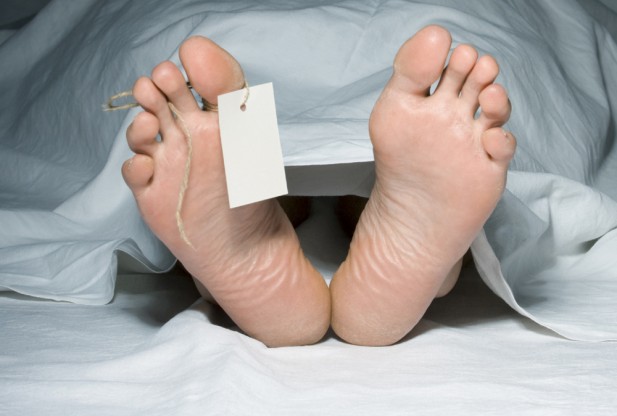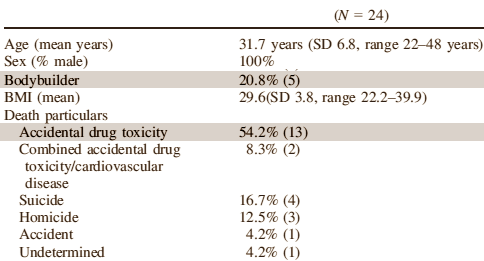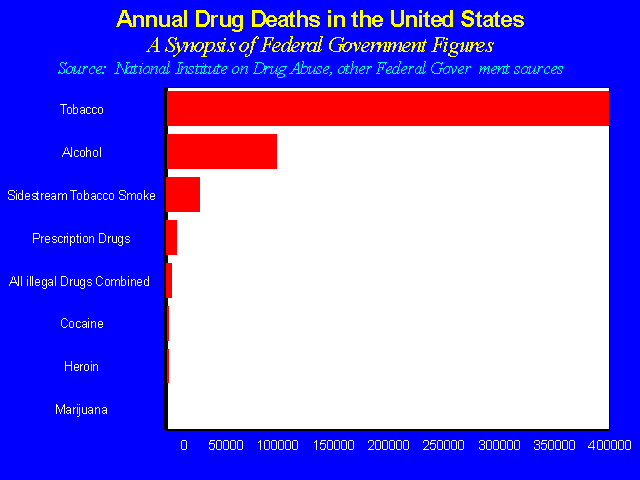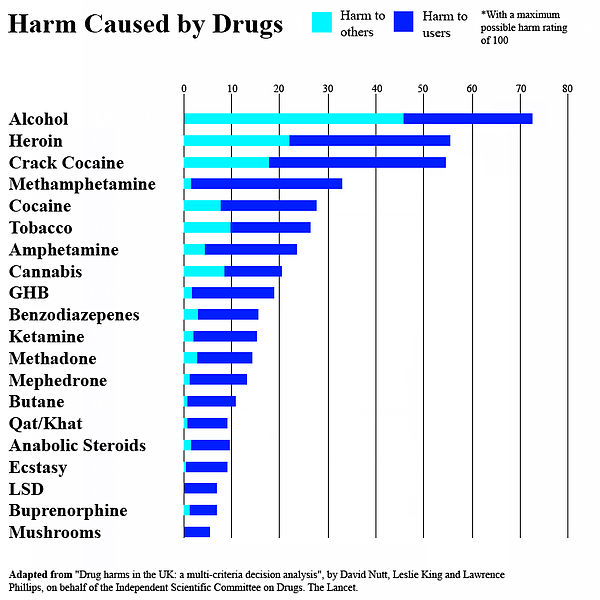Cause of death by steroids users or average Americans
 When somebody dies and the media thinks that person has used steroids, the whole media-circus breaks loose. Look at the deceased professional bodybuilders last year, blunt remarks all over. Actually most steroids where legal not too long ago and their use was meant for treating illnesses.
When somebody dies and the media thinks that person has used steroids, the whole media-circus breaks loose. Look at the deceased professional bodybuilders last year, blunt remarks all over. Actually most steroids where legal not too long ago and their use was meant for treating illnesses.
I did a few posts on the effects of steroid abuse (abuse is something different then use). But let’s put all in perspective. Some people abuse steroids, others alcohol, or (fast) food, are smoking and most important abuse prescription drugs.
Reading this report I was wondering what the cause of death of similar young men would be. And comparing them with this new Australian study. Most people are poly-drug users, some use “legal” drugs (prescription) OTC drugs, recreational drugs or ergogenic drugs, most combine if we also count products we no don’t consider drugs like alcohol. But most of us know how dangerous the combination of recreational drugs and alcohol are, not to mention the fact that some even think they are able to drive. I’m not suggesting that steroids are not significant in ruining someone’s health, they certainly can be. But not if you compare them with other means. If you want to fight a war on drugs then do the job like you should, and also target with the most deadly ones. Just read the numbers and be surprised.
When steroids users die young and unexpectedly, their death is usually not just the result of having taken muscle-enhancing substances. And no, only a fraction of steroids users who die young have participated in bodybuilding competitions. Researchers at the University of New South Wales in Australia discovered this and much more.
The Australians will soon be publishing an article in the Journal of Forensic Sciences in which they summarise the results of 24 post mortems performed on deceased steroids users. The post mortems took place in Sydney between 1996 and 2012.
All of the deceased were men. Their average age at the time of death was 31. Two-thirds of them were in paid employment. Many of those who died had worked as security agents or earned their money as a personal trainer. A few were still studying. An average steroids deceased is therefore not someone on the edges of society.
In two-thirds of the cases the post mortem showed that the men had died from accidental drug toxicity. In one of every three cases, the death was the result of a fatal combination of steroids and stimulants such as cocaine [chemical structure on the right], amphetamines or XTC. In thirty percent of the cases it was a combination of steroids and opiates that was the cause of death.
 In almost all other cases the men had died as a result of crime or suicide.
In almost all other cases the men had died as a result of crime or suicide.
Ninety percent of the deceased were extremely muscular. "Muscular overdevelopment was present in almost all cases, with half having BMIs in the obese range", the researchers write. "These high BMIs were not due to obesity, but to muscle volume and density."
Of the 24 deceased steroids users 23 were polydrug users. In addition to their steroids they had also used mainly stimulatory recreational drugs, but also sleeping pills and sedatives, opiates, alcohol and occasionally also antidepressants.
While doing the post mortems the pathologists noticed damage to the organs in many of the deceased, which was probably the result of substance abuse. Almost half of the steroids users no longer produced sperm for example [Arrested spermatogenesis], had undersized testicles [Testicular atrophy], or had testicles in which healthy tissue had been replaced by connective tissue [Testicular fibrosis].
Interestingly, the pathologists also found crystals [birefringent material] in the lungs of a quarter of all of the deceased. This was probably evidence of material that the deceased had administered via injections or the oral route.
No acne, prostate enlargement or gynaecomastia was recorded.
"In summary, the typical case in this series was a male polydrug user, aged in their early thirties, with drug toxicity the being most common cause of death", the researchers summarize. "Extensive cardiovascular disease was a particularly notable feature."
 Prescription drug abuse now more deadly than heroin, cocaine combined
Prescription drug abuse now more deadly than heroin, cocaine combined
More people are dying in the United States from prescription drugs than from heroin and cocaine combined, a new study says.
Deaths involving prescription pills have quadrupled between 1999 and 2010, according to a report released by Trust for America’s Health, a nonprofit organization in Washington that studies health policy. About 6.1 million people abuse prescription pills, and overdose deaths have at least doubled in 29 states, where they now exceed vehicle-related deaths. In 10 of those states, rates tripled; in four of them, they quadrupled.
The most common misused prescription drugs are painkillers (such as OxyContin, Percocet, and Vicodin), depressants such as sedatives, and stimulants used to treat narcolepsy and attention deficit hyperactivity disorder (ADHD). While men ages 25 to 54 are most likely to abuse these drugs, rates among female abusers are accelerating. Since 1999, overdose deaths have increased 400 percent among women compared with 265 percent among men.
According to the groundbreaking 2003 medical report “Death by Medicine” , 783,936 people in the United States die every year from conventional medicine mistakes. That's the equivalent of six jumbo jet crashes a day for an entire year. But where is the media attention for this tragedy? Where is the government support for stopping these medical mistakes before they happen?
American medical patients are getting the short end of a rather raw deal when it comes to prescription drugs. Medicine is a high-dollar, highly competitive business. But it shouldn't be. Null's report cites the five most important aspects of health that modern medicine ignores in favor of the almighty dollar: Stress, lack of exercise, high calorie intake, highly processed foods and environmental toxin exposure. All these things are putting Americans in such poor health that they run to the doctor for treatment. But instead of doctors treating the causes of their poor health, such as putting them on a strict diet and exercise regimen, they stuff them full of prescription drugs to cover their symptoms. Using this inherently faulty system of medical treatment, it's no wonder so many Americans die from prescription drugs. They're not getting better; they're just popping drugs to make their symptoms temporarily go away.
 But not all doctors subscribe to this method of "treatment." In fact, many doctors are just as angry as the public should be, charging that scientific medicine is "for sale" to the highest bidder – which, more often than not, end up being pharmaceutical companies. The pharmaceutical industry is a multi-trillion dollar business. Companies spend billions on advertising and promotions for prescription drugs. Who can remember the last time they watched television and weren't bombarded with ads for pills treating everything from erectile dysfunction to sleeplessness? And who has ever been to a doctor's office or hospital and not seen every pen, notepad and post-it bearing the logo of some prescription drug?
But not all doctors subscribe to this method of "treatment." In fact, many doctors are just as angry as the public should be, charging that scientific medicine is "for sale" to the highest bidder – which, more often than not, end up being pharmaceutical companies. The pharmaceutical industry is a multi-trillion dollar business. Companies spend billions on advertising and promotions for prescription drugs. Who can remember the last time they watched television and weren't bombarded with ads for pills treating everything from erectile dysfunction to sleeplessness? And who has ever been to a doctor's office or hospital and not seen every pen, notepad and post-it bearing the logo of some prescription drug?
Medical experts claim that patients' requests for certain drugs have no effect on the number of prescriptions written for that drug. Pharmaceutical companies claim their drug ads are "educational" to the public. The public believes the FDA reviews all the ads and only allows the safest and most effective drug ads to reach the public. It's a clever system: Pharmaceutical companies influence the public to ask for prescription drugs, the public asks their physicians to prescribe them certain drugs, and doctors acquiesce to their patients' requests. Everyone's happy, right? Not quite, since the prescription drug death toll continues to rise.
The cause of death in the USA differs from the UK. The diagram from the UK also lists "anabolic steroids". What strikes me and is in contradiction to the Australian study and other studies posted on this blog, is "poly-drug use" as cause of death. ????
International statistics
Every day in the US, 2,500 youth (12 to 17) abuse a prescription pain reliever for the first time.
Prescription drug abuse, while most prevalent in the US, is a problem in many areas around the world including Europe, Southern Africa and South Asia. In the US alone, more than 15 million people abuse prescription drugs, more than the combined number who reported abusing cocaine, hallucinogens, inhalants and heroin.
In 2006 in the United States, 2.6 million people abused prescription drugs for the first time.
A 2007 survey in the US found that 3.3% of 12- to 17-year-olds and 6% of 17- to 25-year-olds had abused prescription drugs in the past month.
Prescription drug abuse causes the largest percentage of deaths from drug overdosing. Of the 22,400 drug overdose deaths in the US in 2005, opioid painkillers were the most commonly found drug, accounting for 38.2% of these deaths.
In 2005, 4.4 million teenagers (aged 12 to 17) in the US admitted to taking prescription painkillers, and 2.3 million took a prescription stimulant such as Ritalin. 2.2 million abused over-the-counter drugs such as cough syrup. The average age for first-time users is now 13 to 14.
Depressants, opioids and antidepressants are responsible for more overdose deaths (45%) than cocaine, heroin, methamphetamine and amphetamines (39%) combined. In the United States, the most deaths used to take place in inner cities in African-American neighborhoods, but they have now been overtaken by white rural communities. The same trend can be seen in the rates of hospitalization for substance abuse and emergency hospitalization for overdoses. Of the 1.4 million drug-related emergency room admissions in 2005, 598,542 were associated with abuse of pharmaceuticals alone or with other drugs.
By survey, almost 50% of teens believe that prescription drugs are much safer than illegal street drugs—60% to 70% say that home medicine cabinets are their source of drugs.
According to the National Center on Addiction and Substance Abuse at Columbia University, teens who abuse prescription drugs are twice as likely to use alcohol, five times more likely to use marijuana, and twelve to twenty times more likely to use illegal street drugs such as heroin, Ecstasy and cocaine than teens who do not abuse prescription drugs.
In 2007, the Drug Enforcement Administration found that abuse of the painkiller Fentanyl killed more than 1,000 people that year in the US. It is thirty to fifty times more powerful than heroin.
- Login to post comments


